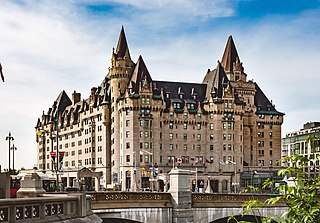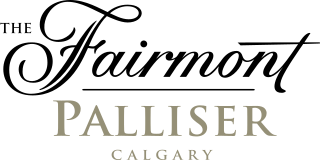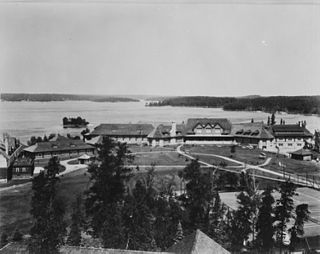
Jasper National Park, in Alberta, Canada, is the largest national park within Alberta's Rocky Mountains, spanning 11,000 km2 (4,200 sq mi). It was established as Jasper Forest Park in 1907, renamed as a national park in 1930, and declared a UNESCO world heritage site in 1984. Its location is north of Banff National Park and west of Edmonton. The park contains the glaciers of the Columbia Icefield, springs, lakes, waterfalls and mountains.

Jasper is a specialized municipality and townsite in western Alberta within the Canadian Rockies. The townsite is in the Athabasca River valley and is the commercial centre of Jasper National Park.

Canadian Pacific Hotels (CPH) was a division of the Canadian Pacific Railway (CPR) that primarily operated hotels across Canada, since passenger revenue made a significant contribution to early railway profitability. CPR restructured the division as a subsidiary in 1963. In 1988, CPR purchased the Canadian National Hotels chain, making Canadian Pacific Hotels and Resorts the nation's largest hotel owner. In 1998, all CPH properties were branded as either Fairmont or Delta.

The Fairmont Château Laurier is a 660,000-square-foot (61,000 m2) hotel with 429 guest rooms in the downtown core of Ottawa, Ontario, Canada, located near the intersection of Rideau Street and Sussex Drive and designed in a French Gothic Revival Châteauesque style to complement the adjacent Parliament buildings. The hotel is above the Colonel By Valley, home of the Ottawa Locks of the Rideau Canal, and overlooks the Ottawa River. The main dining room overlooks Major's Hill Park. The reception rooms include the Wedgewood-blue Adam Room; the Laurier Room defined by Roman columns; the Empire-style ballroom and the Drawing Room featuring cream and gold plaster ornament. The hotel was designated a national historic site in 1980.
Fairmont Hotels & Resorts is a global chain of luxury hotel that operates more than 70 properties worldwide, with a strong presence in Canada.

The Fairmont Banff Springs, formerly and commonly known as the Banff Springs Hotel, is a historic hotel located in Banff, Alberta, Canada. The entire town including the hotel, is situated in Banff National Park, a national park managed by Parks Canada. The hotel overlooks a valley towards Mount Rundle, both of which are situated within the Rocky Mountain mountain range. The hotel is located at an altitude of 1,414 metres (4,639 ft).

The Fairmont Hotel Macdonald, formerly and commonly known as the Hotel Macdonald, is a large historic luxury hotel in Edmonton, Alberta, Canada. Located along 100 Street NW, south of Jasper Avenue, the hotel is situated in the eastern end of downtown Edmonton, and overlooks the North Saskatchewan River. The 47.7-metre-high (156 ft) hotel building was designed by Ross and MacFarlene and contains eleven floors. The hotel is named for the first prime minister of Canada, Sir John A. Macdonald.

The Fairmont Palliser, formerly known as the Palliser Hotel, is a hotel of the Canada-based Fairmont Hotels and Resorts chain. The historic hotel (1914) is located in downtown Calgary, Alberta, at 133 9 Avenue SW adjacent to the Calgary Tower and Palliser Square. The Palliser is one of Calgary's oldest and most luxurious hotels.

The Algonquin Resort is a Canadian coastal resort hotel in the Tudor Revival style, located in St. Andrews, New Brunswick. An architectural icon of New Brunswick, the hotel is the most famous symbol of St. Andrews and one of the most photographed buildings in the province.

Banff Sunshine Village is a ski resort in western Canada, located on the Continental Divide of the Canadian Rockies within Banff National Park in Alberta and Mount Assiniboine Provincial Park in British Columbia. It is one of three major ski resorts located in the Banff National Park. Because of its location straddling the Continental Divide, Sunshine receives more snow than the neighbouring ski resorts. The Sunshine base area is located 15 km (9 mi) southwest of the town of Banff. By car, it is about a ninety-minute drive from the city of Calgary; the Sunshine exit on the Trans Canada Highway is 8 km (5 mi) west of the town of Banff.

The Fairmont Le Château Montebello, formerly and commonly known as the Château Montebello, is a historic hotel and resort complex in Montebello, Quebec, Canada. The resort complex includes a large game reserve and a large wooden structure. The wooden hotel structure was developed by Victor Nymark.

Canada's grand railway hotels are a series of railway hotels across the country, each a local and national landmark, and most of which are icons of Canadian history and architecture; some are considered to be the grand hotels of the British Empire. Each hotel was originally built by the Canadian railway companies, or the railways acted as a catalyst for the hotel's construction. The hotels were designed to serve the passengers of the country's then expanding rail network, and they celebrated rail travel in style.
Stanley Thompson was a Canadian golf course architect, and a high-standard amateur golfer. He was a co-founder of the American Society of Golf Course Architects.

National Park Service rustic – sometimes colloquially called Parkitecture – is a style of architecture that developed in the early and middle 20th century in the United States National Park Service (NPS) through its efforts to create buildings that harmonized with the natural environment. Since its founding in 1916, the NPS sought to design and build visitor facilities without visually interrupting the natural or historic surroundings. The early results were characterized by intensive use of hand labor and a rejection of the regularity and symmetry of the industrial world, reflecting connections with the Arts and Crafts movement and American Picturesque architecture.

Lac Beauvert, or Beauvert Lake is a small lake (0.4 km2) in Jasper National Park, Alberta, Canada.
Canadian National Hotels was a hotel chain under control by Canadian National Railways. In addition to their own hotels, it acquired some from predecessor railway companies like the Grand Trunk Pacific Railway, Grand Trunk Railway and Ottawa, Arnprior and Parry Sound Railway. Some of their assets were later acquired by rival Canadian Pacific Hotels after 1988.
The Highland Inn (1908–1957) was a year-round resort hotel built and operated by the Grand Trunk Railway (GTR), in Ontario’s Algonquin Provincial Park. It was located near the park offices on the northern edge of Cache Lake, and was a focal point for the park for many years. Wishing to return the park lands to a more natural state, the Inn was purchased by the Ontario Government in 1956 and removed. Today all that remains are traces of the concrete stairs and platform that met the CNR line, which was lifted after departure of the last train in 1959.

Minaki Lodge, formerly part of the chain of Canadian National Hotels, was originally built in 1914 by the Grand Trunk Pacific Railway (GTPR). Located on the route of the National Transcontinental Railway (NTR) at Minaki, Ontario, between Sioux Lookout and Winnipeg, where the railway crosses the Winnipeg River, the rustic resort hotel named Minaki Lodge and the railway station, also called Minaki, is an Ojibwa word that has been variously translated as "beautiful water" or "good land."

Bryce Canyon Lodge is a lodging facility in Bryce Canyon National Park, Utah, United States, built between 1924 and 1925 using local materials. Designed by architect Gilbert Stanley Underwood, the lodge is an excellent example of National Park Service rustic design, and the only remaining completely original structure that Underwood designed for Bryce Canyon National Park, Zion National Park, and the North Rim of the Grand Canyon.

The Grand Canyon Lodge is a hotel and cabins complex at Bright Angel Point on the North Rim of the Grand Canyon. It was designed by Gilbert Stanley Underwood, who designed a number of other hotels in national parks for the Utah Parks Company and other concessioners. Built in 1927–28, the Grand Canyon Lodge resort complex consists of the Main Lodge building, 23 deluxe cabins, and 91 standard cabins, some of which were moved to the north rim campground in 1940. All guests are housed in cabins detached from the main lodge, which serves as a dining, concessions and service facility. Constructed of native Kaibab limestone and timber, the complex was designed to harmonize with its rocky and forested setting. The Grand Canyon Lodge complex is notable for its setting and rustic design, as well as its status as the only complete surviving lodge and cabin complex in the national parks.




















